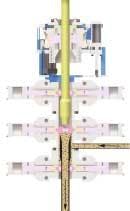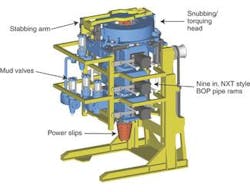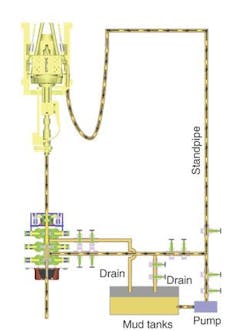Continuous drilling fluid circulation while making connections
Varco has developed a system that enables continuous circulation of drilling fluid throughout the drilling process - even while making and breaking drill pipe connections. For the first time since rotary drilling was introduced, a section of hole can be drilled without interrupting circulation while new joints of drill pipe are added to the drill string. This was made possible by the use of Varco’s Continuous Circulation System (CCS), Jim Brugman, Varco product development manager, says.
The idea, concept, and patent came from Laurie Ayling, who at the time was working with a small UK consulting company for offshore subsea developments called Maris International,” Brugman says. The UK’s Industry Technology Facilitator (ITF), which helps small companies obtain the necessary funds to develop technologies and businesses, funded him. Most of the money came from a Joint Industry Project (JIP) Maris International managed, six major oil companies (Shell UK, BP, Statoil, BG, Total, and Eni), Coupler Development Ltd. (CDL), and Varco.
null
Although Maris International did not have the capabilities to do the heavy-duty design, development, and manufacturing, Varco’s pipe-handling and pressure-control capabilities provided the technologies needed to develop the CCS.
By not having to shut off the mud pumps, you can:
• Reduce total connection time by 75%
• Enable continuous cuttings transport
• Optimize the solids control processes
• Enhance/enable other technologies
• Do true underbanced drilling (UBD)
• Enable liner drilling (creates dynamic annulus above bit)
• Narrow pore pressure/frac gradient drilling
• Reduce problems with shallow water flows
• Reduce stuck pipe incidents
• Eliminate ballooning effects
• Drill difficult formations
• Reduce the likelihood of kicks.
Some of the technical challenges included pipe dope washing off, pipe thread damage from mudflow, tool joint location inside the CCS, thread engagement force minimization, pipe ram seal life reduction, pipe ram frictional forces, unit tie down, and top drive connection with extended saver sub.
To meet these challenges, Varco tested pipe dope retention, thread compound verification, tool joint erosion, tool joint torque control, and ram rubber development prior to a live well field test. The tests resulted in advances in technology and use of correct materials for application.
Coupler concept
The CCS had to rely on advances in top drives, drill pipe handling equipment, BOP ram seals, iron roughnecks, and computerized drilling control systems. The heart of the CCS is the coupler, which evolved from Ayling’s earlier work on a seabed-located drilling rig. A device separated the drilling fluid from the seawater while adding or removing drill pipe from the drill string. The significance of such a device and its potential impact on improving drilling efficiency lead to the establishment of the JIP to develop the system, starting in October 2000.
A sealing device divides the pressure chamber into two sections. Pressure bleeds off in the upper chamber, allowing the pin connection to be removed. Meanwhile, circulation continues without interruption to the drill string through the lower chamber.
null
The new drill pipe joint, connected to the top drive, runs into the upper chamber, which is sealed and repressured with drilling fluid from the circulating system. With pressure equalized, the dividing seal opens, the new drill pipe joint decends, and the connection is made up with circulation continuing through the drill string. The pressure in the chamber bleeds off, the seals open, and drilling re-starts. Usually, 50-60 stands are made up before changing out the coupler rubbers, which takes about 5-15 min using the quick-opening Shaffer NXT doors.
Field trial
According to Brugman, “The field trial of the CCS took place between July 31 and August 2, 2003 on a BP well. The CCS was used while drilling a section of 12 1/4-in. hole and drilled trouble free at around 200 ft/hr with a conventional top drive rig. The unit operated reliably and successfully, making 62 single connections which resulted in placing 1,930 ft of tubulars without interruption to circulation. This has never been done before in the history of mankind.”
The operating data from the rig and the CCS transmitted via the Internet to the Varco E-Drill Control Center in Houston where Varco monitored and recorded the data. The data indicated connection times varied between 12 and 15 min versus 30 min to 2 hr circulation for bottoms-up, pending operator’s preference. There was no guidance system in the derrick because of the limitations of the rig, and stabbing the top drive extension/wear sub into the new drill pipe single took longer than Varco expected. A truer indication of connection time was around 8 min, the time taken for the sequential mechanical operations of the CCS.
The coupler is a pressure chamber on the rig floor over the rotary table. The drill string passes through the coupler, which seals around the drill pipe pin and box during the connection process.
Following the completion of the field trial, Varco dismantled, checked, and rebuilt the prototype coupler as the first production model. Alterations to the jacking system, supporting framework, and layout resulted in reduced weight and footprint size. The dimensions of the production model are height 8.2 ft, footprint 6.5 ft x 5 ft and weight 14.5 tons.
“A large part of the effort recently has been the completion of the control system, which is fairly sophisticated,” Brugman says. An “undo” command was added to the system for any problem situation that needed to be reversed. “An example of this is that we have thread compounds resistant to washing off, but if there was a delay in connecting, the system would warn you that the joint should be redoped. This would require writing software to go backwards at any point in the sequence, which was extremely difficult.”
Varco conducted all of the design, manufacturing, and software development at the Houston facility.
“Currently, the prototype has been converted into Serial No.1 of the production model of the CCS and has recently completed all of the required testing,” Brugman says.
To make a connection, drilling fluid at circulating pressure flows into the pressure chamber, equalizing the pressure inside and outside the drill string. The connection breaks and the tool joint pin backs out and raises clear of the box.
Two other units are in manufacturing and will be completed at the end of the year. All three units will be identical.
“Current plans are to send Serial No.1 for an operator in the JIP to Italy on a land site for the training and evaluation by their people in December and then possibly on to one of their offshore properties for actual field operations,” Brugman says. According to the agreement, all of the original JIP members have free use of the tool for one application. Another major operator is waiting to activate a unit for the Gulf of Mexico to drill through the rubble zone below the salt. They believe that with a continuous circulation system the operator can reduce or eliminate the problems.







